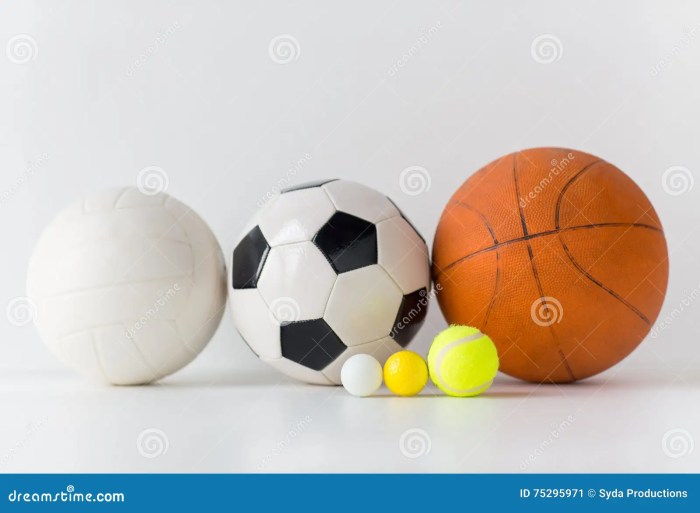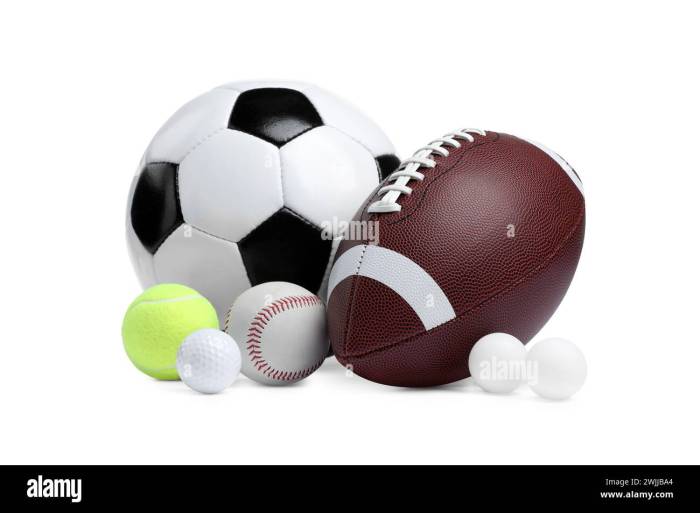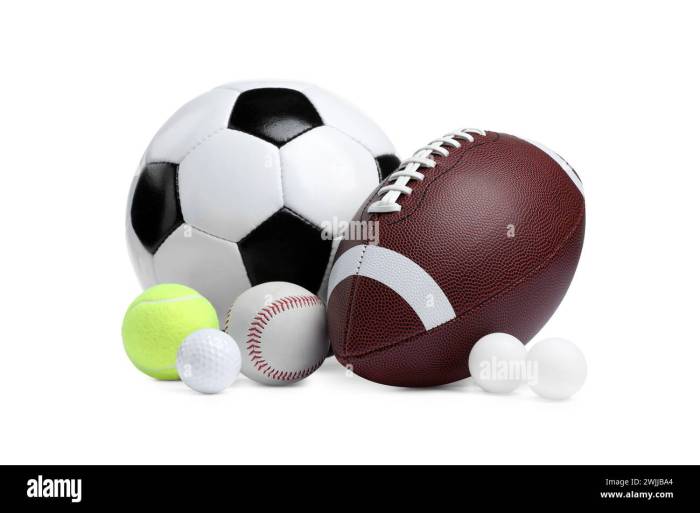Every sport that has a ball, from the fast-paced excitement of basketball to the strategic precision of soccer, offers a unique blend of athleticism and strategy. This exploration delves into the fascinating world of ball sports, examining their diverse characteristics, global reach, and cultural significance.
We’ll define what precisely constitutes a “ball sport,” categorize them by type, and compare and contrast their rules, strategies, and equipment. We’ll also explore the global popularity of these sports and how cultural factors influence their variations. Get ready for an insightful journey through the fascinating world of ball sports!
Defining “Sport with a Ball”
A sport with a ball is a competitive physical activity involving the use of a ball, either directly or indirectly, to achieve a goal. The fundamental element is the object itself—the ball. This differentiates these sports from other physical activities like swimming, gymnastics, or track and field, which might involve equipment but not a ball in the same crucial manner.The core principle of a ball sport often revolves around maneuvering and manipulating the ball to score points, advance in the game, or strategically outmaneuver opponents.
This encompasses a wide range of skills, from simple catching and throwing to complex passing, dribbling, and hitting techniques. The specific rules and strategies vary significantly depending on the sport.
Types of Balls Used
Different sports require different ball characteristics to suit the specific demands of the game. The materials, sizes, and shapes are crucial in influencing the dynamics and strategies employed by the players. For example, a basketball needs a certain bounce and weight to facilitate dribbling and shooting, whereas a tennis ball needs a particular lightness and elasticity to be easily hit and propelled across the court.
Criteria for Categorizing a Ball Sport
To classify an activity as a ball sport, certain criteria must be met. Firstly, the use of a ball is paramount; the ball is the fundamental object of play. Secondly, the activity involves structured rules governing the use of the ball, the movement of players, and the methods of scoring. Thirdly, the activity’s primary objective is often to score points or achieve a specific outcome related to the ball’s use, such as reaching a goal, knocking down pins, or returning the ball over a net.
Variations in Ball Characteristics
The variations in ball size, shape, and materials are significant across different sports. Size directly impacts the force required to manipulate the ball, influencing the tactics and strategies employed. Shape affects the trajectory and bounce of the ball, impacting the type of skills required for playing the game. Materials determine the ball’s weight, durability, and responsiveness to player interaction, all contributing to the sport’s overall dynamics.
Ball Characteristics Comparison Table
| Sport | Ball Type | Size (approx.) | Material |
|---|---|---|---|
| Basketball | Inflated leather/synthetic | Large | Leather/Synthetic |
| Soccer | Inflated leather | Medium | Leather/Synthetic |
| Tennis | Felt-covered rubber | Small | Rubber/Felt |
| Volleyball | Inflated leather/synthetic | Medium | Leather/Synthetic |
| Baseball | Leather-covered cork | Medium | Leather/Cork |
| Handball | Inflated leather/synthetic | Medium | Leather/Synthetic |
| Badminton | Cork/plastic | Small | Cork/Plastic |
| Golf | Hardened rubber | Small | Rubber |
Categorizing Ball Sports

Ball sports, a diverse and engaging realm of competition, offer a fascinating study in categorization. From the fast-paced action of a basketball court to the strategic maneuvering of a soccer field, understanding how these sports are classified can illuminate their unique characteristics and shared traits. This exploration delves into the various ways ball sports can be grouped, highlighting the strengths and weaknesses of different approaches.
Classifying Ball Sports by Gameplay
Categorizing ball sports by their gameplay mechanics provides a useful framework for understanding their structure. Team sports rely on cooperation and shared goals, while individual sports emphasize personal skill and achievement. This distinction significantly impacts the dynamics and strategies employed within each category.
| Category | Examples |
|---|---|
| Team Sports | Basketball, Football (American), Soccer, Volleyball, Baseball, Hockey |
| Individual Sports | Tennis, Golf, Badminton, Table Tennis, Squash |
Classifying Ball Sports by Playing Environment
The location where a ball sport is played often dictates the rules and strategies involved. Indoor sports often have a tighter, more controlled environment, whereas outdoor sports benefit from wider spaces and the elements.
| Category | Examples |
|---|---|
| Indoor Sports | Basketball, Volleyball, Table Tennis, Badminton, Squash |
| Outdoor Sports | Soccer, Football (American), Baseball, Cricket, Tennis, Golf |
Sports that Don’t Fit Neat Categories
Some ball sports defy simple categorization. For example, racquetball combines elements of both indoor and individual play, or even some variants of basketball, like three-on-three, challenge traditional team-based approaches.
From soccer to basketball, every sport that has a ball requires precision and skill. It’s fascinating how different those skills can be, but they all share that core element. Recently, though, a different kind of ball game has been playing out, with former Giants RB Derrick Ward pleading not guilty to robbery charges. This case highlights the complexities of life outside the realm of sports, but the underlying themes of strategy and competition remain, even in legal proceedings.
Ultimately, every sport that has a ball has its own unique drama, from the court to the field.
Non-Ball Sports
While this discussion focuses on ball sports, it’s important to acknowledge other athletic pursuits. Many activities, such as swimming, track and field, gymnastics, and martial arts, are considered sports despite not using a ball. The key defining characteristic is the athleticism, competition, and adherence to specific rules and regulations.
Comparing and Contrasting Ball Sports: Every Sport That Has A Ball
Ball sports, encompassing a vast array of activities, differ significantly in their rules, strategies, playing environments, physical demands, and equipment requirements. Understanding these variations provides insight into the unique characteristics of each sport and the diverse experiences they offer. This exploration will delve into the contrasts between various ball sports, illuminating the specific demands and characteristics of each.A key aspect of appreciating ball sports is recognizing the tailored approaches they demand.
Different ball sports call for distinct skill sets and strategic considerations, shaping the players’ actions and overall gameplay. The playing fields, from the meticulously marked basketball court to the expansive soccer pitch, further contribute to the varied nature of these activities. Furthermore, the physical toll each sport imposes on athletes varies considerably, requiring different training regimens and physical attributes.
From soccer to basketball, every sport that has a ball demands precision and skill. It’s fascinating how even seemingly trivial details, like whether or not a star player like Kawhi Leonard got a haircut after a recent fight, can become viral news. This story, which highlights the attention surrounding the Clippers star, shows how the world of sports, especially those with a ball, can be filled with more than just the game itself.
The article on clippers kawhi leonard didnt get haircut despite viral photo at tank davis fight is a great example of the interesting narratives that can emerge within these contexts, showing just how much more than just the game itself is out there in every sport that has a ball.
Rules and Strategies
Different ball sports employ unique sets of rules and strategies. Understanding these differences is crucial for appreciating the intricacies of each game. The objective of the game, the permissible actions, and the scoring mechanisms all contribute to the overall dynamic. For instance, in basketball, scoring is primarily achieved through shooting, while in volleyball, it involves hitting the ball over a net.
Playing Fields/Courts/Surfaces
The playing surfaces and dimensions significantly influence the style and strategy of a ball sport. A basketball court’s rectangular shape and marked zones dictate the movement of players and the effectiveness of different plays. Conversely, a soccer field’s vast expanse encourages a different approach to the game, with a greater emphasis on covering ground and precise passing. The material of the surface, whether hard court, grass, or sand, also impacts the ball’s trajectory and the players’ movement.
Physical Demands
The physical demands of different ball sports vary considerably. Basketball, with its bursts of speed and agility, demands a high level of cardiovascular fitness, while soccer requires sustained endurance and a wide range of movement skills. Volleyball necessitates jumping ability and agility, while tennis requires quick reflexes and powerful arm movements. The specific physical demands of each sport dictate the type of training athletes need to undertake.
Equipment and Gear
The equipment required for each ball sport is tailored to the specific demands of the game. Basketball players need basketballs, sneakers, and appropriate protective gear. Soccer players require soccer balls, cleats, and shin guards. Volleyball players need volleyballs, specialized shoes, and appropriate attire. The specific equipment and gear used in each sport are designed to enhance performance and ensure safety.
Challenges and Opportunities
Each ball sport presents its own set of challenges and opportunities. Basketball players face the challenge of consistently hitting the basket, while soccer players need to navigate through the dynamic field environment. Volleyball players must contend with the unpredictability of the ball’s trajectory, while tennis players need to manage the strategic complexities of the game. Each sport offers the opportunity to hone specific skills and develop physical attributes, leading to personal growth and accomplishment.
From soccer to basketball, every sport that has a ball relies on strategic plays and intense competition. Right now, though, wrestling fans are buzzing about WWE rumors surrounding Cody Rhodes, Roman Reigns, Solo Sikoa, Ricochet, and Chad Gable contract negotiations. These rumors are creating a lot of excitement and speculation, just like any big game, and ultimately, the outcome will likely impact the future of the sport.
Ultimately, whether it’s a ball or a wrestling ring, the intensity and strategy are always at the heart of every game.
Comparison of Rules (Basketball vs. Volleyball)
| Sport A | Rule 1 | Rule 2 | Sport B | Rule 1 | Rule 2 |
|---|---|---|---|---|---|
| Basketball | Players dribble the ball to move. | Scoring is achieved by shooting the ball into the hoop. | Volleyball | Players hit the ball over a net. | Scoring is achieved by hitting the ball so it lands on the opponent’s court. |
Global Distribution of Ball Sports
The global landscape of ball sports is a vibrant tapestry woven from threads of cultural significance, historical context, and evolving popularity. Different regions embrace various ball sports, often reflecting their unique histories and values. Understanding this distribution provides insight into the diverse ways humans interact with competition and leisure.The global spread of ball sports is not a random phenomenon.
Historical trade routes, colonization, and cultural exchange have all played crucial roles in shaping the current distribution map. Modern communication and media have further accelerated the spread of popular sports, leading to a fascinating interplay between local traditions and international trends.
Popularity of Ball Sports in Different Regions
Different regions of the world exhibit distinct preferences for various ball sports. For example, the popularity of soccer is exceptionally high in South America and Africa, deeply intertwined with the cultural identity of those nations. This passion often translates into significant investment in infrastructure and the development of local talent. In contrast, the popularity of basketball is particularly strong in North America, where it enjoys a prominent position in the sports landscape and a vast professional league.
Regional Variations in Rules and Playing Styles
Cultural factors significantly influence the rules and playing styles of different ball sports. For instance, variations in soccer rules can be seen across different countries, reflecting regional customs and preferences. These variations often highlight the rich tapestry of cultural nuances within the sport. Similarly, the emphasis on strategy and individual skill can differ between various basketball leagues around the world, leading to diverse playing styles.
Cultural Significance of Ball Sports
Many ball sports hold deep cultural significance in different countries. For example, the FIFA World Cup is a major global event that unites millions across different nations and backgrounds. This widespread participation demonstrates the uniting power of sport and its cultural impact. Similarly, the Olympics, which feature many ball sports, offer a platform for international cultural exchange and competition.
The cultural value placed on sports often mirrors the overall values of the society.
Examples of Popular Ball Sports by Country
| Country | Popular Ball Sports |
|---|---|
| USA | Basketball, American Football |
| Brazil | Football (Soccer), Volleyball |
| India | Cricket, Kabaddi |
| Japan | Baseball, Rugby |
| Argentina | Football (Soccer), Basketball |
| England | Football (Soccer), Cricket |
| Mexico | Football (Soccer), Baseball |
| Australia | Australian Rules Football, Cricket |
| Germany | Football (Soccer), Basketball |
Historical Origins of Popular Ball Sports
The origins of many popular ball sports are rooted in ancient traditions and cultural practices. For instance, many scholars believe that football (soccer) evolved from various forms of kicking games played in ancient civilizations. Similarly, the history of basketball can be traced back to the development of indoor games in the late 19th century. Understanding the historical context provides a deeper appreciation for the evolution of these sports.
A Note on Future Trends
The global distribution of ball sports is continuously evolving. Technological advancements and the increasing interconnectedness of the world are likely to influence the future of these sports. For example, the rise of online gaming and virtual reality could create new avenues for participation and fan engagement.
Variations in Ball Sports Equipment
The equipment used in ball sports has undergone significant evolution, driven by technological advancements and the need for improved performance and safety. From simple leather balls to sophisticated composite materials, the journey reflects a constant interplay between tradition and innovation. This evolution impacts not only the game’s dynamics but also the athletes’ experience and the overall enjoyment of the sport.The diversity of ball sports necessitates a variety of ball designs and materials.
Each sport demands specific characteristics from its equipment, influencing the ball’s size, weight, texture, and construction. These variations are crucial for ensuring fair play, optimal performance, and safety for the participants.
Different Types of Balls Used in Specific Ball Sports
Various ball sports employ distinct ball types, tailored to the specific demands of each game. Basketball, for instance, utilizes a spherical ball made of leather or synthetic materials, often featuring a bladder for inflation. Its size and weight are standardized to ensure consistent play. Soccer employs a spherical ball constructed from leather or synthetic materials, with specific standards for its size, weight, and inflation pressure.
The characteristics of these balls influence the game’s dynamics, allowing for effective passing, kicking, and scoring.
Evolution of Ball Materials and Designs Over Time
Early ball materials often relied on natural resources. For example, indigenous cultures frequently used animal skins or plant fibers to craft balls for games. Over time, the use of leather gained prominence. This material offered durability and a manageable texture. Modern advancements have led to the development of composite materials, like synthetic polymers, which have improved ball performance in terms of durability, consistency, and responsiveness.
These materials are more resistant to damage and offer better control during play.
Impact of Technology on Equipment Development
Technological advancements have revolutionized the design and manufacturing of ball sports equipment. Computer modeling, for example, helps engineers optimize ball shapes and materials for better aerodynamics and bounce. Sophisticated testing procedures ensure balls meet specific performance standards. These advancements translate to more predictable and consistent gameplay. For instance, the development of high-performance synthetic materials has allowed for the creation of balls with enhanced durability and consistent performance in different weather conditions.
Importance of Specific Equipment in Each Sport
The importance of specific equipment in each sport is undeniable. In baseball, the ball’s weight and texture play a critical role in the game’s strategic dynamics. The material of the ball, its size, and its weight dictate how the ball is pitched and how the batter interacts with it. Similarly, in volleyball, the ball’s size and material influence the players’ ability to hit and control the ball during the game.
The specific characteristics of the ball significantly affect the strategy and execution of the game.
Safety Features Incorporated into Various Ball Sports Equipment, Every sport that has a ball
Safety is a paramount concern in ball sports equipment design. Modern materials often incorporate features that enhance safety, such as padded grips or specially designed seams to prevent injuries. The design of the ball itself can impact the risk of injury. For example, smoother surfaces reduce the risk of abrasions during contact. Safety features like these ensure that players can participate in the sport with minimal risk of harm.
Table Illustrating Differences in Ball Materials Used for Different Sports
| Sport | Ball Material | Rationale |
|---|---|---|
| Tennis | Leather/Synthetic | Leather provides durability and a consistent feel, while synthetic materials offer a more predictable bounce. |
| Basketball | Leather/Synthetic | Leather offers a good grip and feel, while synthetic materials are more resistant to damage and water absorption. |
| Soccer | Leather/Synthetic | Leather offers a traditional feel, while synthetic materials are more durable and often more affordable. |
| Volleyball | Leather/Synthetic | Synthetic materials are more resistant to damage and provide a consistent feel and flight path. |
Ultimate Conclusion

In conclusion, every sport that has a ball represents a unique tapestry of athleticism, strategy, and cultural expression. From the individual challenges of tennis to the teamwork of basketball, the shared element of a ball unites these diverse sports. We’ve explored the nuances of their rules, equipment, and global reach, highlighting the fascinating interplay between physical skill, strategy, and cultural context.
This deep dive into ball sports has shown just how rich and varied this world truly is.



